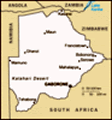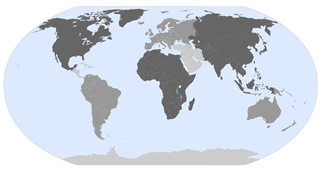Advertisement
Published: March 15th 2017
5 -12 July 2010
Reminiscence of past travels
My discomfort from sitting on the hard makeshift wooden stool was minimal. A dusty cloud of trepidation hung around me as I waited for my fate to be revealed. The Sangoma (witchdoctor) picked up a grubby bag and tipped the contents into his hand. He cupped his hands together, shook them, and mumbled a few words that I didn’t understand. Puffing through a gap between his thumbs, he whisked his hands apart. Polished bones tumbled and exploded in all directions to a standstill on the dusty red Kgalagadi sand. The Sangoma looked at me with sad eyes and shook his head. A few sluggish minutes ago, before I sat on the chair, my anxious utterings were “I hope he’s at least going to tell me that fortune will favour the brave and that I will become abundantly wealthy.” What fate awaited me?
Ok, enough of the dramatics. Rewind to almost seven years ago, July 2010. We had arranged to go on a safari through one of the tour operators advertising in a local 4 x 4 magazine. It would be a guided vehicle convoy with a tour operator, providing logistical
support and safari tents that would be set up for us each night. Included would be recovery equipment, radio communication as well as breakfast and dinner. All we had to do was drive in our own vehicle. We also had to provide our own snacks, lunches and drinks other than tea or coffee. A few other items we had to bring were our own bedding, including a mattress and camping chairs. Other costs that were excluded were travel insurance, park fees and border post costs. Any other activities would also be for our own pocket.
Another important item we had to supply was 40L of water – 20 for kitchen use and 20 for our own use at a dry camp. A tip given to us for those days without water were wet wipes. Sounds ridiculous when you think you’re going to a wetland. Malaria prophylaxis was also a necessity.
The Okavango River flows into a parched Kalahari Desert from the Angolan highlands. It crosses Namibia’s Caprivi Strip and spreads into a unique pulsing wetland with a vast ecosystem. The Okavango Delta covers between 6 000 and 15 000 square kilometres of Kalahari Desert in northern
Botswana where it eventually evaporates.
Our first overnight stop was in Botswana at Camp Itumela, Palapye without the group. We stayed in one of the permanent tents and slept on a concrete bed with a mattress. Fortunately it was comfortable and warm, because that night it was bitterly cold.
It is a popular stop en route for tour groups but we were doubtful that we would get dinner at the restaurant because the place looked deserted when we arrived. We did get fed though, and it was quite pleasant. As we ate, tour groups snuck in one by one. Throughout the night music pumped as the young crowd got together and had a good time; no-one put off by the cold. The following morning as we were leaving, we were even exposed to someone running around in droopy underpants. Must have been a heavy party the night before.
We drove to Khama Rhino Sanctuary, the meeting point for our tour group.
Our itinerary was as follows:
Day 1 – Khama Rhino Sanctuary – Serwe pans We arrived early and spent the afternoon driving around Khama. We saw enough animals to
whet our appetite for the rest of the trip. We then met the rest of our tour group at our camp and introduced ourselves. Around a fire with huge cast iron pots, our dinner bubbled like a witches brew. We sat in a circle around the fire and sampled Shortie, our chef’s food. His name, legendary in the 4 x 4 circles had preceded him. He certainly lived up to it. There was food for Africa, plentiful and very tasty.
Day 2 – En route to Letlhakane. Travel through villages onto the ancient super lake of isolation – the Makgadikgadi Pans. Shortly after leaving the following morning we stopped at a village next to the side of the road. On a rickety makeshift wooden table was an assortment of so called ‘Muti’ in an array of liquor bottles, baby milk powder tins and Vaseline jars. Dubiously I volunteered to have my fortune told and sat in a wheelbarrow shaped chair. My Sangoma shook his hands, and tossed his bits of wood and bones onto the dry Kalahari sand. His revelation; “You’ll cross mighty water and see many animals.” Of course I chuckled with relief afterwards.
We continued our journey and eventually turned off the tar onto a sand road very much like beach sand. Only problem was we were nowhere near the sea. We stopped for lunch under a baobab and snacked on biscuits and cheese. After lunch we drove for a while on a track between trees, then the terrain opened and we caught our first glimpse of the salt pan stretching for miles.
Once a lake, Lake Makgadikgadi, now it is mostly dry except at certain times of the year. The pan is in the middle of dry savannah and is one of the largest salt flats in the world.
In the wet season you are sure to get stuck if you don’t adhere to the road, which continues as a sandy track. In this wide open space the crust on the surface can be treacherous. Numerous vehicles have been stuck, leaving their mark, unable to get out without assistance. Even some intrepid explorers with woolly hair and wild beards – but I won’t mention names.
Through sand and grass we stayed on the track till we caught sight of an insignificant raised section in the distance. The closer we
got the more spectacular it became. An island of granite rose above the pan, an oasis of magnificent baobab trees reached haphazardly towards the sky from between the rocks. This was Lekhubu Island, affectionately known as Kubu island. It was the ‘dry’ camp with no ablutions and very rickety long drop toilets that were best avoided. What you took with, left with you – say no more. This was where the 20L of water would be used for a bush shower or if you so wished, you could stick to wet wipes. Your choice.
As we arrived, camp was already set up. All we needed to do was freshen up (with those handy wet wipes) and enjoy sundowners on the pan. We drove as far as Kalbas, our tour guide would allow and felt comfortable that we would not sink in. A unique experience, one that I will never forget. Sitting on the pan, doing a full 360 degrees, and the only thing in sight in one direction where the sun was setting was Kubu island. For the rest, all that the eye could see was salt pan.
Another scrumptious dinner, under bright stars in a pitch black
sky, truly unforgettable. We could get used to this life.
Paul and I and a few others rose early to watch the sun rise over the pan as well. It was well worth it, with the pale first light on the granite, the baobabs stood ghostlike till the sun cast a golden glow on them.
Day 3 – Maun - gateway to the Okavango Delta. It was difficult to leave that morning after watching such a spectacular sunrise. We only did so with the knowledge that there would be other interesting places to see. We drove to Maun and restocked on fuel, and a few supplies.
Late afternoon, just outside Maun we reached our camp. The welcome warm showers were bliss because by now we were gritty with dust. The following morning those that wanted could go for a 15 minute scenic flight over Okavango Delta before we would head further north. This was yet another highlight, fascinating to see a small portion of the vast stretch of the Okavango wetlands from the sky. Seeing it from up there gave us a totally different perspective looking down on the Delta.
Day 4 – Northwards to Okavango Delta
Travelling north deeper into the Okavango, the briefing we’d had filled our minds with a mixture of excitement and trepidation. This would be our first water crossing of the trip. We weren’t sure what lay ahead but evidence of rivers overflowing in places concerned us. There had been above average rainfall that season and the flood levels were exceptionally high. We weren’t sure how deep the crossing would be but we were promised that we would only go through water that was wheel arch height.
At the first sight of water, we had to follow the line that our guide, Kalbas, took. This was not just a river crossing. It was an expanse of water. We were advised to follow the demarcated area, tape attached to poles, or you could end up being swallowed by an invisible cavity. What we really had to do was put our trust in someone who had done this many times before. It didn’t take long for one of the vehicles to get stuck and they needed to be towed out. This meant the entire convoy halted and stood in various levels of water. One of the
rules we were reminded of continuously, is to keep your engine running, don’t stall.
I took the duty of navigator and photographer, not that I did much, and left the driving to Paul. He also decided to add the job of photographer to his title. If it’s your first time on an unknown road, hidden by a mass of water, it can be quite daunting. Our convoy shuffled along till we got to the last section just before camp. The bridge across this area had washed away and we were faced with another challenge. One by one we ploughed through the water and once again a vehicle or two needed to be towed out. Fortunately we got through without a problem. Well done to Paul.
We were well and truly in this unique ecosystem, a true oasis situated in the middle of the largest stretch of continuous sand in the world, the Kalahari basin. That night and the next we were at an island camp, in the Okavango Delta. During the night a hippo roamed around our camp, but unfortunately we didn’t catch a glimpse of it. Not that I really would want to get too close to
a hippo. Its mouth is far bigger than my head.
Something we chose to ignore for the next day was that we had to leave the island the way we came in. Would we ever get out?
To be continued… NB. I have decided to break this blog up into two, because there are so many photos and I found it hard to remove some, so that you paint a better picture in your mind as to what we saw and experienced. Please remember to look at the other pages of the blogs containing just photos.
See the next blog:
My future predicted by a Sangoma Part 2
Advertisement
Tot: 0.48s; Tpl: 0.016s; cc: 24; qc: 92; dbt: 0.1652s; 1; m:domysql w:travelblog (10.17.0.13); sld: 1;
; mem: 1.4mb





















